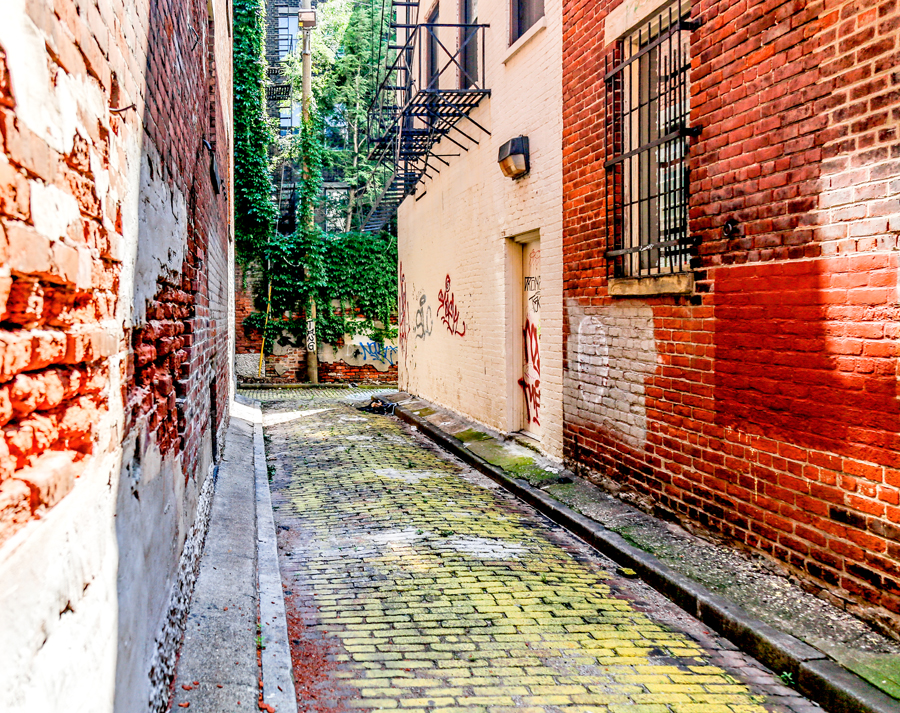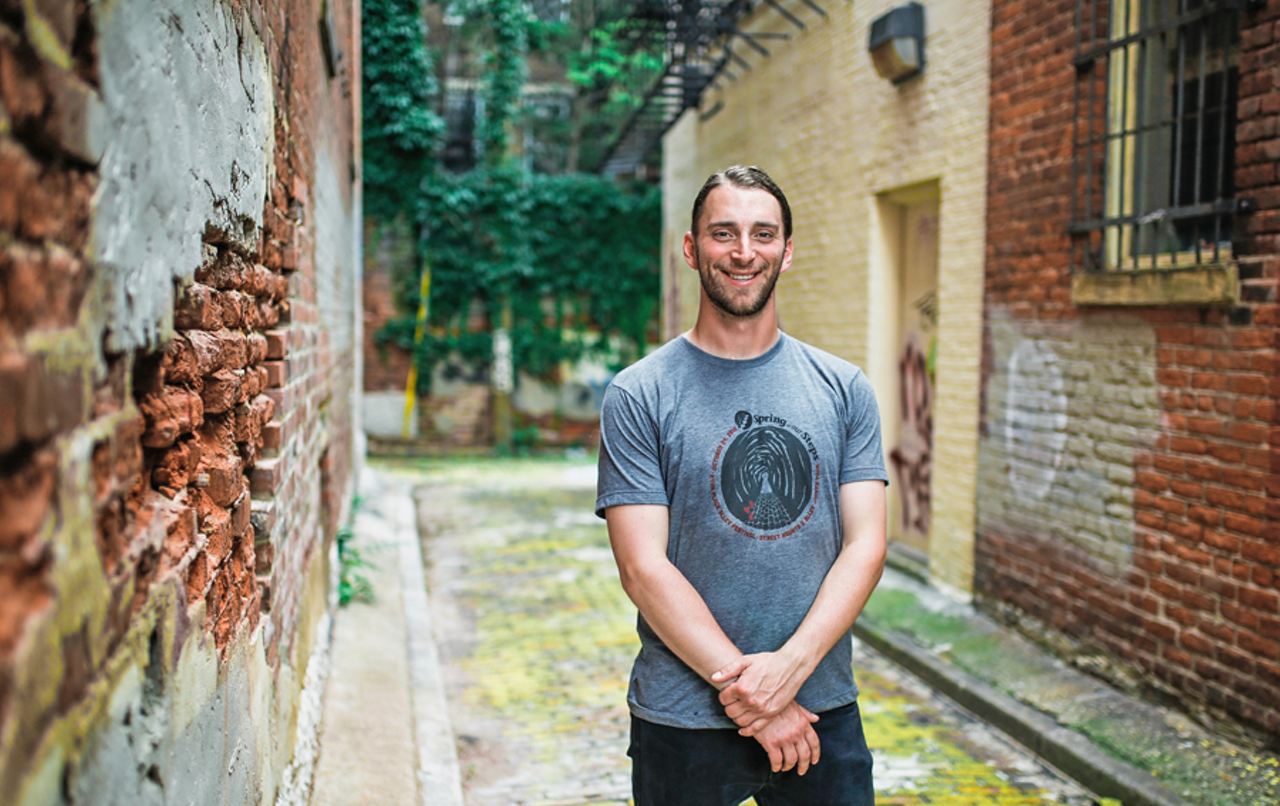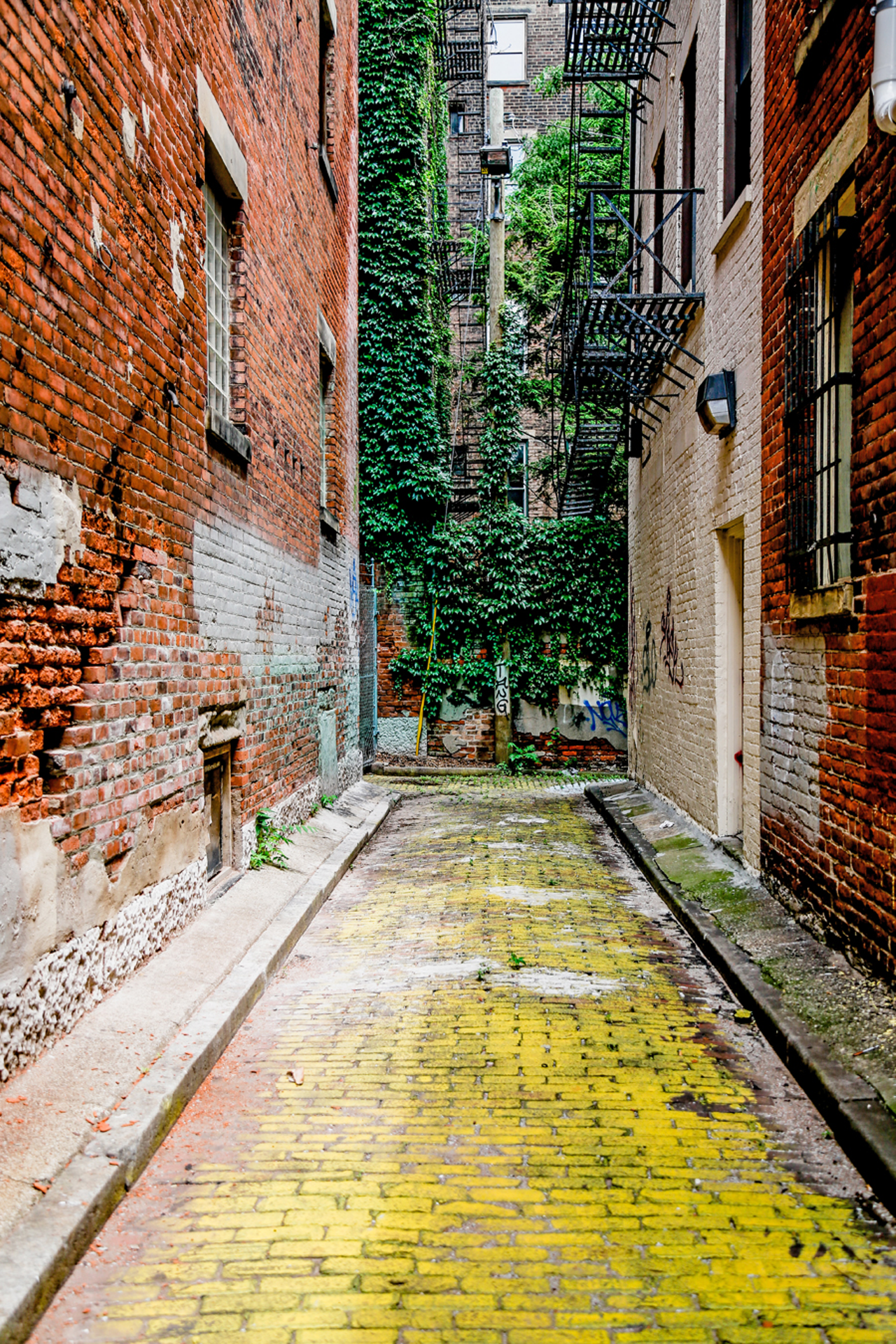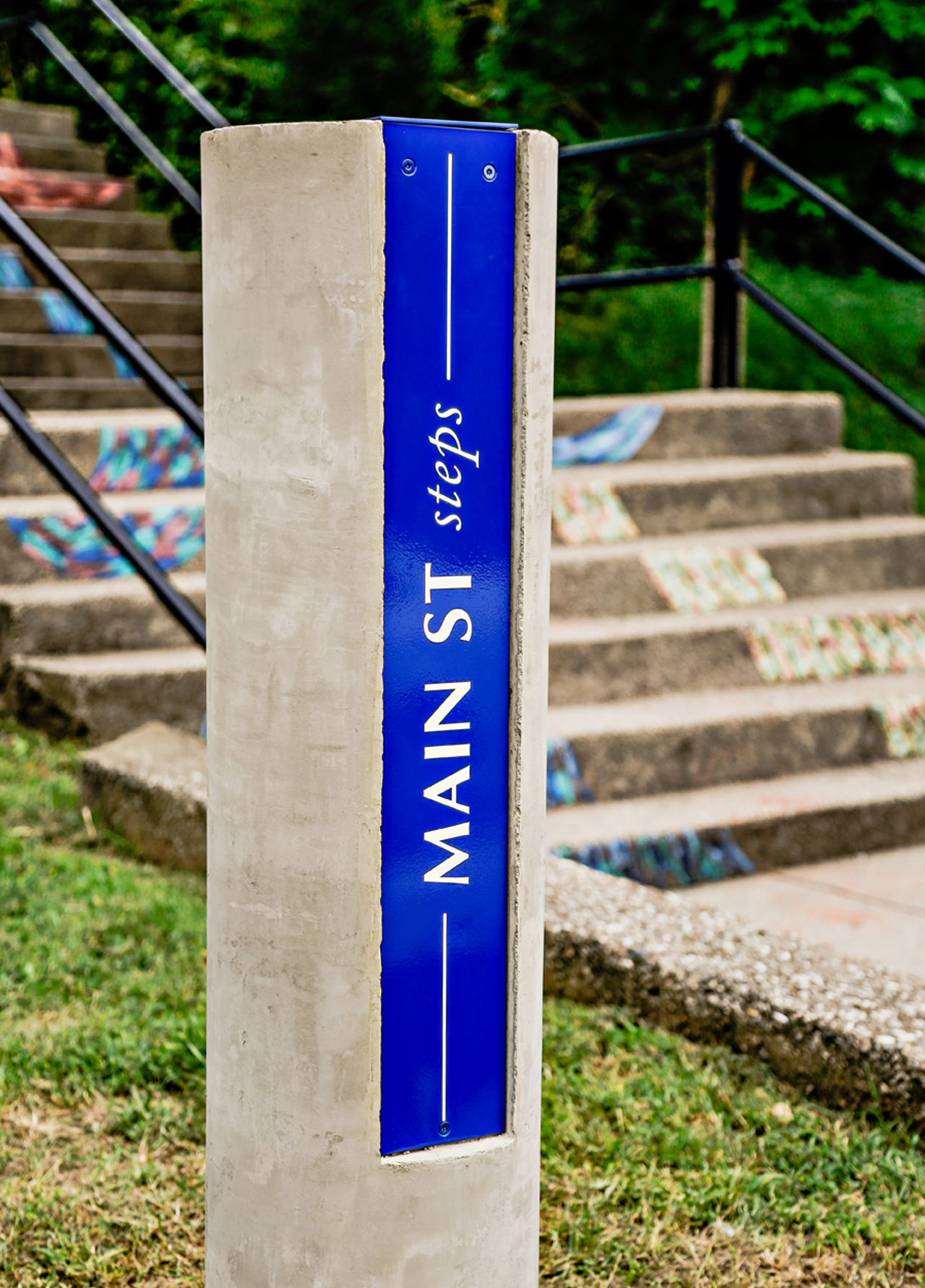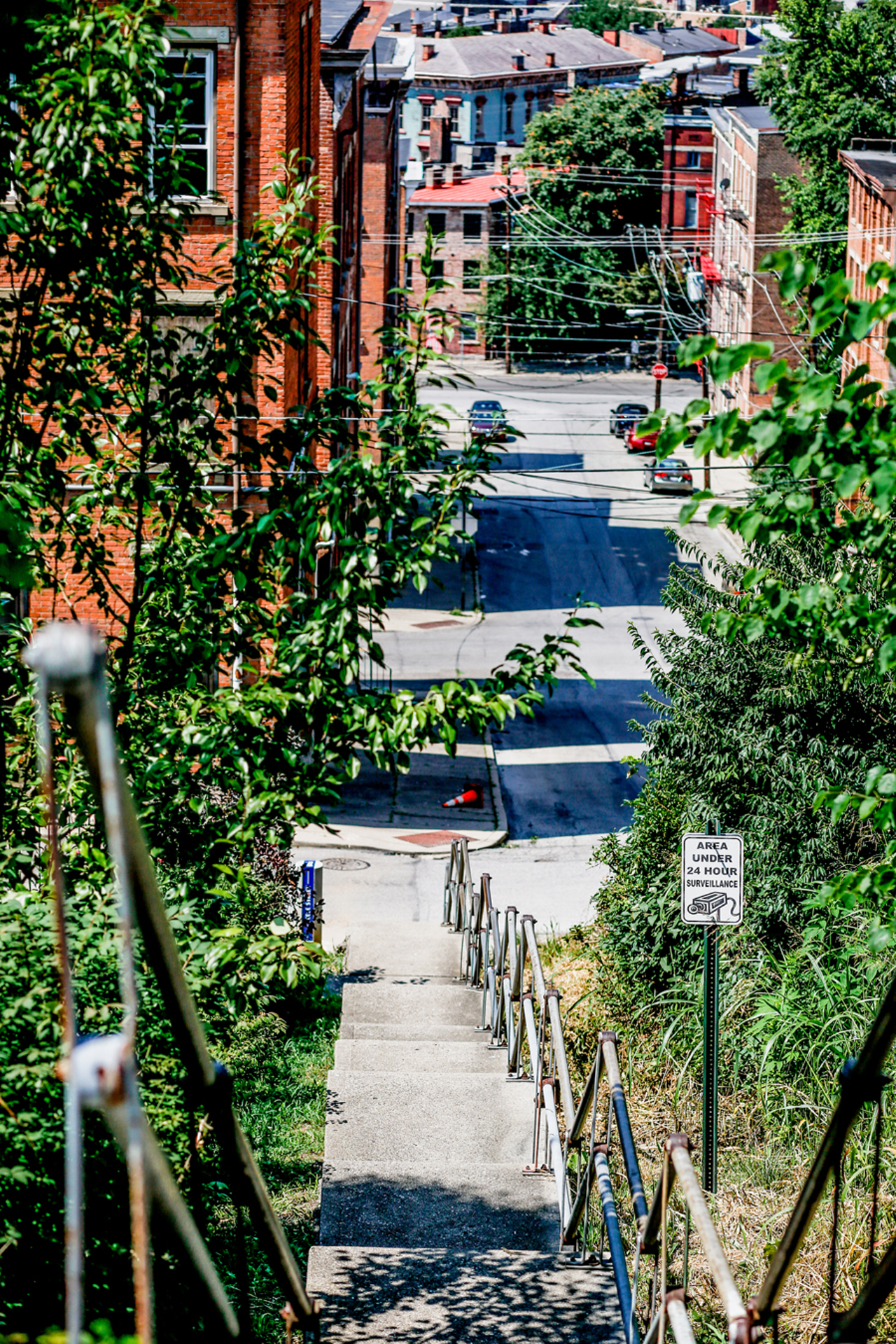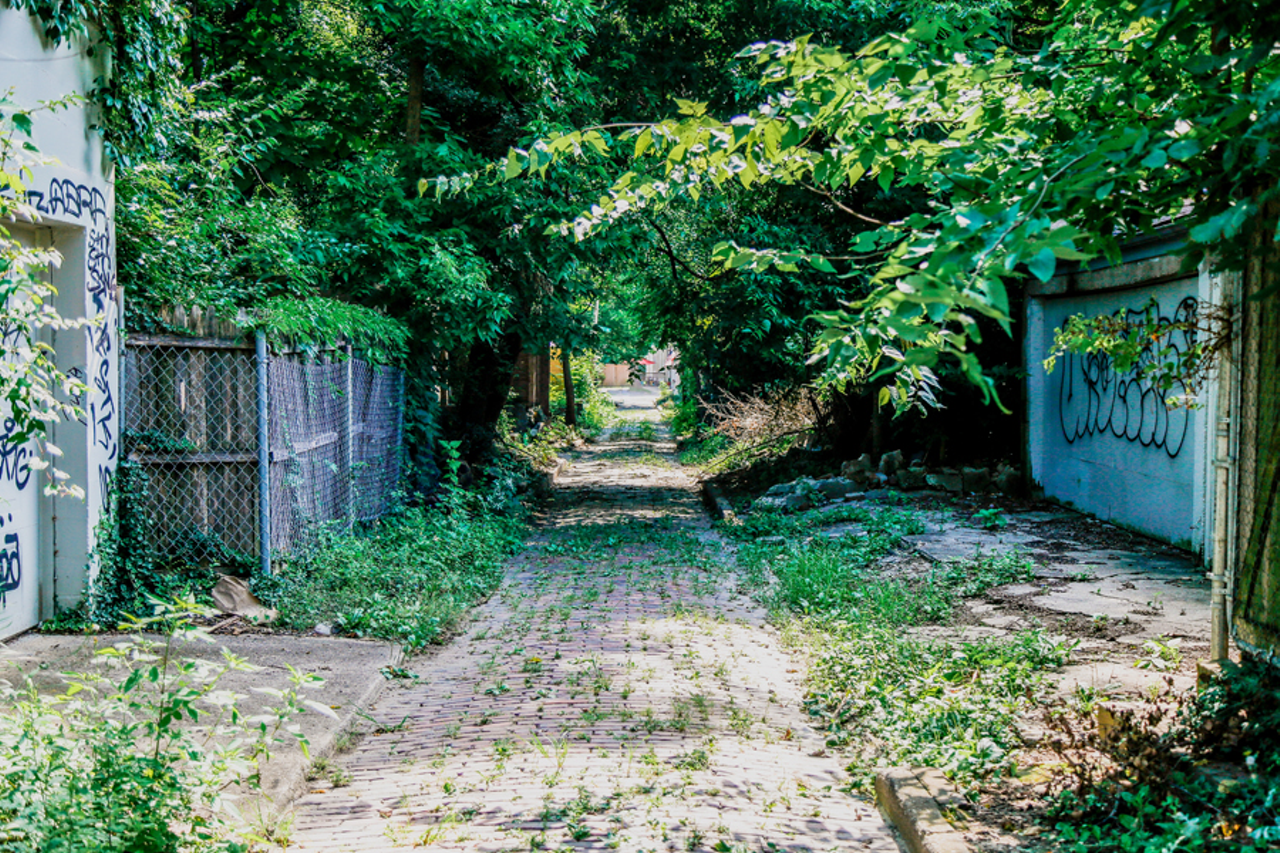Christian Huelsman enjoys wearing a T-shirt with a back designed to look like a roll call of stops on a Rock band’s North American tour, only instead of New York, Los Angeles, Boston, Toronto, etc., these names are decidedly unfamiliar to most of us: Colby Alley, Nagel Alley, Manchester Avenue, Renner Street, Unnamed Alley Steps, Saint Joe Street, South Wendell Alley, Rice Street Steps, Sharp Alley, Glanker Street, Goose Alley, Eton Place.
Closer inspection of the shirt reveals that it is commemorating the 2015 Eton Place Alley Festival, a 2.1-mile walking tour and activation of “street haunts and alley jaunts” hidden in Cincinnati. You may well have missed the event, held in Mount Auburn and Over-the-Rhine. But if Huelsman — co-founder of the 6-year-old organization Spring in Our Steps, which has received nonprofit status — has his say, you’ll be hearing much more about such spaces in the years ahead. Especially the alleys, most of which are brick-lined. Cincinnati has slightly more than 500, according to his research.
Huelsman has a dream for alleys to become urban spaces that are as beautiful and cherished as our parks. This is pretty radical — many of us see them as often gritty, littered, bad-smelling and sometimes dangerous places to get through as quickly as possible and only if you must. But he expresses that dream so poetically, with such effusive romanticism, that you want to succumb. Here’s the passionate cri de coeur, the declaration of love, that he wrote on social media several years ago for South Wendell Alley in Mount Auburn, the subject of an early and difficult cleanup by Spring in Our Steps:
“This place remains my sanctuary, symbolic of every turn, U-turn and detour my heart has taken over nearly four years. It has cajoled more sweat to drip from my body, inflicted more nicks and cuts, prompted more palpitations from my chambers and awarded more tears of joy than even the mostly six years it took to finish my degree. But it’s all a journey. I can’t imagine my life without this space, this alley and all it represents…”
The degree Huelsman mentions is an undergraduate degree in urban planning from University of Cincinnati’s College of Design, Architecture, Art and Planning. As for the arduous cleanup, which among other things uncovered the near-secret existence of an overgrown public stairway, he wrote, “I’ve done it for nothing but I’ve done it for everything: to survive and thrive.”
Spring in Our Steps is a small organization with just four board members, including Huelsman. (A fifth position is open.) It was founded in 2011 by him and Pam Sattler. For its alley and stairway cleanups, it has relied on volunteers. For current income, which it has used for community events, it has relied on a $10,000 grant from the Carol Ann and Ralph V. Haile Jr./U.S. Bank Foundation.
But its advocacy of the emotional bond between contemporary Cincinnatians and our public alleys, many of which date to the 19th century and have outlived their original purpose of providing a rear service entrance for buildings, has struck a chord.
“Their value is in the historic granite curbs and the bricks,” says Jules Michael Rosen, Spring in Our Steps board member. “They’re just as much a historic asset as the buildings are downtown.” (Though Rosen believes public stairways — another of the organization’s focuses — hold more promise than alleys as urban pedestrian thoroughfares.)
That belief in alleys as a great civic resource has support from the city, too. “Alleys are certainly public assets, and by their nature and role in Cincinnati’s fabric, a historic asset,” says Michael Moore, director of the Department of Transportation & Engineering (DOTE), via email. “They are called out in (a section) of the Cincinnati Municipal Code and their use and/or restoration requires review on a case-by-case basis.”
As a result of that city support, on a recent Friday afternoon Huelsman attended the dedication of a new, long-percolating cooperative project between DOTE and Spring in Our Steps. Wearing that distinctive T-shirt, he arrived at the foot of the Main Street Steps to meet a small group of others.
This project is the Stairway & Alley Signage Project, involving the placement of 12 concrete bollards, with aluminum sign panels, along eight pedestrian gateways on the hillside between Mount Auburn and Over-the-Rhine. DOTE’s Moore says this $20,000 project was chosen because the steps, especially, can help get neighborhood students to Rothenberg Academy, a public school. But they’re for everyone. Once all are in place, some intersections whose locations would test the best Cincinnati Uber drivers or postal carriers, such as the junction where Peete Street, Peete Alley and the Peete Street Steps all meet, will have identification signs that also say, “Pathway cleared by Spring in Our Steps.”
“(That) means we have adopted them per our maintenance agreement,” Huelsman says. “We have agreed to host regular cleanup events to ensure regular surface maintenance (trash pickup, weeding, etc.) of these spaces … so that they continue to be viable, safer pedestrian connections in the community.”
Remarkably, Huelsman had come in for the event from Minneapolis, where he’s been working for the past year as a community livability specialist for that city’s downtown improvement district, as well as being a member of Minneapolis’ Pedestrian Advisory Committee. He has stayed active in Spring in Our Steps despite his distance and activities out of town, organizing local events, planning the signage and posting about city alleys on social media.
“Christian has done an incredible job of managing things, even from Minneapolis,” says Spring in Our Steps co-founder Sattler. She’s been less active in recent years, but attended the signage project’s dedication.
“There’s been more awareness from the city that there are people paying attention to these spaces,” she says. “There’s definitely a stronger connection with the city, just knowing there are people paying attention to these spaces and that they do matter.”
Huelsman’s larger vision is to see public acceptance for a concept called “living alleys,” which serve the public-at-large rather than just being where businesses get deliveries or load products.
“In a living alley, it’s about how people interact with the space, whether they are making use of it for leisure or brunch/lunch activities,” he says. “It’s about bringing in elements that attract people.”
This may sound counterintuitive, since cities already have open streets and sidewalks, plazas and parks as focal points for human activity. Urban alleys — narrow and often lined with buildings that create shadows and feel enclosing — are generally little used or, worse, used for such nefarious activities as public urination.
But Huelsman believes they have great potential if made more accessible and inviting for pedestrian use and activity. “There is a natural human inclination to go where people feel secure and feel they have full visibility of their environment,” he says. “A person’s interaction with a space, when their back is to a wall, creates a sense of control over the experience. So the enclosure of an alley works for the purpose of creating comfort. It allows people to feel they have full scope of what their surroundings are.”
The trick, he says, is to recreate the alley “as a focal point for human activity.” (Also, he points out, to the extent that cars use alleys, they tend to be driven at much slower speeds than on streets. Thus, they are less of a threat to pedestrians than thoroughfares.)
This is a transformation that’s not going to come without challenges, as a walk along the Stairway & Alley Signage Project route reveals. As Peete Street starts to turn into the much narrower Peete Alley at one end, the terrain begins to get rugged and a little bit weird. Graffiti on a chunk of rock points to “free hugs” awaiting adventurous urban explorers willing to go off-road. As the alley portion begins, there are a couple buildings, at least one of which looks vacant. Unnerving graffiti can be seen, like “If $ Is the Foot.”
Worse, it looks like the alley’s rare surface of 19th-century cobblestone pavement — it’s one of the city’s few cobblestone alleys — has been removed. Perhaps someone came back to this remote spot with a large vehicle, possibly to do some construction work, Huelsman suggests; there’s also a dumpster placed in the area. Spring in Our Steps had spent three years cleaning up this space, highlighting the cobblestone.
“We put a lot of time and energy into it,” Huelsman says. “But it’s hard to keep people accountable when it’s not being cared for or there’s nobody there to care for it.”
This is a problem elsewhere, too. Even Huelsman’s beloved South Wendell Alley has gotten overgrown again. (On a subsequent visit along Peete Street and Peete Alley by CityBeat photographer Hailey Bollinger, the dumpster and possibly some of the graffiti were gone.)
Amazingly, as we stand around this area and bemoan the visible destruction, a young man comes seemingly out of nowhere, nonchalantly walking up a pathway that doesn’t even seem to exist but is where the alley subtly bends, tightens and continues downward to Vine Street. He is carrying a bag with some purchased items and walks right past our small group without stopping. “If it’s an available pathway, people are going to use it,” Huelsman says.
Spring in Our Steps realizes they need to organize residents of the areas where it works to maintain their alleys and steps. “Engagement with residents, not just in the immediate communities of these spaces but also with volunteers in general, has been a huge struggle for us,” Sattler says.
But there are other people and organizations standing up for our alleys. Sometimes literally. Margy Waller, an Over-the-Rhine resident and community activist, almost got arrested last summer trying to protect quiet Adrian Alley from damage.
“I was working at home early in the morning and heard a loud noise coming from the alley behind my house,” she says. “I looked out my window and saw there was a big piece of equipment drilling through the bricks. So I went to see what was going on and it was a contractor for the city’s Water Works — they needed to get into the line underneath the alley. I asked them to stop because I was pretty sure they weren’t supposed to be drilling through historic bricks.”
She is right on this — DOTE’s Moore says his department’s 2016 Street Restoration Manual demands that “methods and materials used in making the permanent restoration shall match the existing pavement or surface conditions or be replaced as directed by the DOTE Inspector.” But it took Waller awhile to get that point through to the contractor, who wanted to keep working. She took action to protect the bricks.
“Eventually, I stepped in front of the machine onto the bricks so they had to stop,” she says.
A more artful example of Over-the-Rhine alley revival occurred last year when ArtWorks and Keep Cincinnati Beautiful collaborated on 14 mini murals along alleys between Main and Sycamore streets, south of Liberty Street. Called New Lines, this program included the alleys Goetz, Plough, Cogswell, Enon and Bland. “It was both to increase pedestrian use and access and to decrease blight and litter and make people feel safe so they could walk through alleys,” says Keep Cincinnati Beautiful’s Marissa Reed.
New homeowners — and new residents of Cincinnati — are discovering the pleasure of neighborhood alleys. There’s a good example in Northside, where a network of them sometimes crisscrosses its streets. Some are in good shape and access garages behind homes; others are overgrown and tough to navigate. Some folks might see them as a nuisance, a detriment to privacy, but Kelly Johnson and husband Chris Kerns saw them as a real plus when they moved from a “cookie-cutter” Northern Kentucky subdivision into a custom-built home on Fergus Street between Lingo Street and Chase Avenue. (There are two new homes on the street so far.)
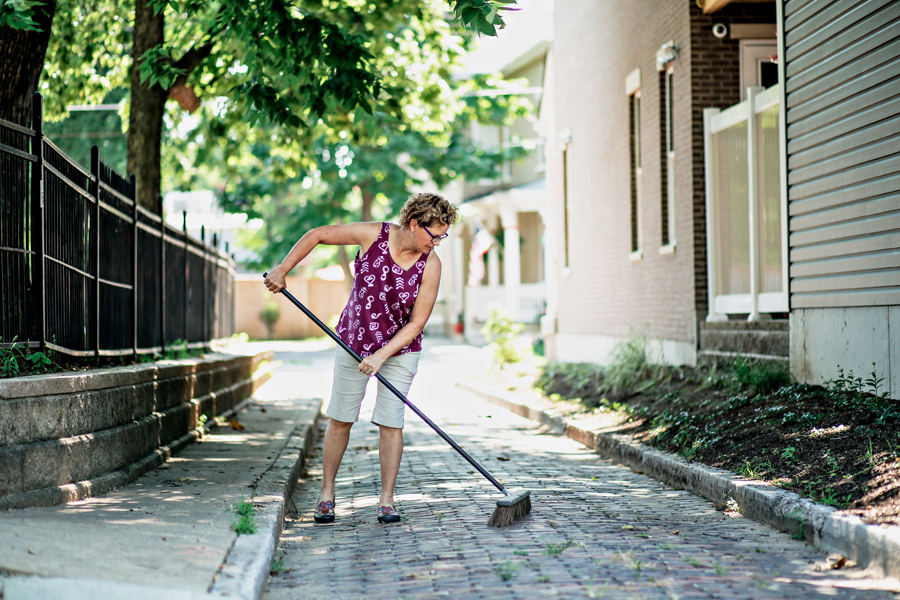
They are right at the intersection of Gray and Pope alleys; the entrance to their garage is on Gray and the couple has started sweeping their portion of Pope. They are out to revive their small segments of Northside’s alley grid.
“One of the features we really liked was the idea of keeping the alleys,” Johnson says. “We walked those alleys to different places around Northside when we were first thinking of building here. We loved that they connected to the main drag of Hamilton Avenue. It’s such a lovely walk along Pope Alley, though there are definitely some spots that need to be cleaned up. And I feel like I can walk the dog without having to worry about cars. We’ve considered the idea of keeping our alley looking good all the way to Hamilton.”
The opposite of alley revival is alley removal — and it does happen. DOTE’s Moore says the city has turned down requests to vacate, sell or privatize portions of alleys, as in a request by Chatfield College to take a portion of Kemp Alley in Over-the-Rhine. But, if there’s a compelling reason, as in a developer’s recent request for a portion of downtown’s alley-sized Bowen Street for a planned Kroger grocery and residential tower, the city might agree.
“Vacation and sale of an alley is not common, but the city probably averages two requests per year and approximately five or six requests for leases each year,” Moore says. “However, not all of these requests are granted.”
Huelsman and Spring in Our Steps would just as soon see none granted. “The sale of alleys to private interests eliminates options for pedestrians and opportunities to develop the city in more dynamic ways,” he says. “The leasing and gating of alleys only provide a short-term safety solution. Alleys should remain public and receive the same amenities we consider in making our streets and sidewalks safer and more desirable.”
The next Spring in Our Steps community event occurs Friday, beginning at 6 p.m., and Huelsman will be back from Minneapolis for it. It’s called the Dead End Film Festival and will also have some music, “lawn” bowling and other activities, in a very surprising and even eerie locale. It’s where two Over-the-Rhine alleys, Coral and Drum, meet to form a “T” between Main and Clay streets, just north of East 13th Street. Coral between Drum and East 13th can be a little gamey — during a visit with Huelsman, a syringe and socks lay on a curb near the brick pavement, which had been painted a light blue. There was trash near a garage door that faced the alley. But beyond that — behind a fenced-off and gated dead-end portion of Coral — was a more picturesque, kinder and gentler stretch of alley. There was what seemed to be an oasis, where trees grew in the right-of-way. And someone, Banksy-style, had stenciled two white tulips on a building wall. Spring in Our Steps has gotten access beyond the padlocked fence and on Friday night will project short films in this space. It’s possible the dead-end portion of Coral might someday become Spring in Our Steps Park.
“Over the years, we’ve cleaned up that space behind the gate tremendously,” Huelsman says. “It used to be covered in tall weeds, beer bottles and all sorts of siding had been disposed there. We really take ownership of the space and continue to improve upon transgressions of the past.”
All Cincinnati alleys should have such dedicated champions. But perhaps, with Spring in Our Steps, they all do.
SPRING IN OUR STEPS presents the Dead End Film Festival Friday at Coral and Drum alleys in Over-the-Rhine. More info: springinoursteps.com.
Ten Interesting Alleys
Christian Huelsman, co-founder and executive director of Spring in Our Steps, finds these 10 Cincinnati alleys especially interesting.
Colby Alley (Over-the-Rhine)
An extensive granite block alley with a view of Rhinegeist (formerly a Christian Moerlein bottling plant) that runs behind structures from the former Moerlein empire and ends at the foot of the old Jackson Brewery/Metal Blast Building. From Eton Place to West McMicken Avenue.
Combs Alley (Camp Washington)
Zigzags and angles of settled brick that weave through Camp Washington’s well-loved northern half, from Valley Park and the World War I Doughboy statue to the interstate. From Bates Alley to Massachusetts Avenue.
Corn Alley (West End)
A rare exhibition of cobblestone paving terminating at the rear of the historic Lafayette-Bloom School building. From Freeman Avenue to its eastern terminus.
Fortview Alley Steps (Mount Adams)
A picturesque alley stairway featuring two beautiful homes with exclusive access via steps. From Hill Street to Fortview Place.
Goetz Alley (Over-the-Rhine)
Spanning nearly the full depth of OTR south of Liberty Street and running parallel to Main Street, it offers an intimate neighborhood experience with a window into the city's lush hillsides. From Michael Bany Way to Liberty.
Pope Alley (Northside)
A popular walking route beginning with a piazza at the business corridor and running to the Northside Children's Playground. From Hamilton Avenue to Fergus Street.
Schorr Alley (Clifton Heights)
The lengthiest known alley without intersecting streets, it climbs steadily from the original commercial core in Clifton Heights to today's bustling business district near the University of Cincinnati. From Warner Street to West McMillan Street.
Sharp Alley (Over-the-Rhine)
An inclined walking route with an identity crisis, it starts as a brick alley, continues with granite paving near the former Hudepohl Brewery and flows onward as an alley stairway. From Back Street to Mulberry Street.
South Wendell Alley (Mount Auburn)
From the former estate of beer baron Christian Moerlein, it travels past the dwarfing stone retaining wall and wilderness along its length and ends at a long-closed public stairway. From Mulberry Street to St. Joe Alley.
Weaver Alley (Downtown)
A nearly three-block stretch beginning at Doerr Alley that crawls under a sky bridge at The Phoenix, passes by a mix of historic and contemporary buildings along Garfield Place and goes to Plum Street and the front steps of City Hall.

